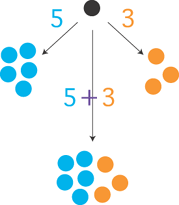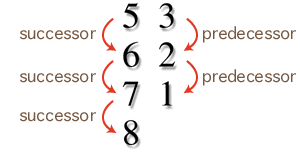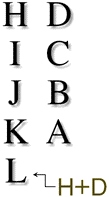- In general, the "sum" (the symbol "+") is defined for numbers as what is used to express "sum of ratio".
Thus, in the case of the natural number, it is illustrated like this :

- On the other hand, the operation for getting the sum of the numbers of elements is :
Thus, as for the natural number, the "sum" algorithm is defined as follows.

The term of the sequence resulted by this algorithm from the terms m and n is denoted by "m + n" and called the "sum of m and n".
(In our example, "5 + 3" is "8".)
And this algorithm is called the "addition".
Let's practice the "sum" algorithm !

Suppose we have a natural number that goes like this.
What is H+D ?

- The "addition" of the natural number is defined as the fuction which corresponds, to two numbers, their sum.
In this stage, the word of "natural number" is introduced. In fact, the sequence associated with the structure of the "addition" is called the "natural number".






